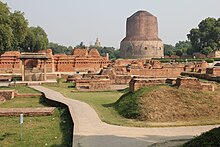Buddhism is an Indian religion attributed to the teachings of Buddha.[15][16]
The details of Buddha's life are mentioned in many early Buddhist texts
but are inconsistent, his social background and life details are
difficult to prove, the precise dates uncertain.[17][note 1]
The evidence of the early texts suggests that he was born as Siddhārtha Gautama in Lumbini and grew up in Kapilavatthu,[note 2] a town in the plains region of modern Nepal-India border, and that he spent his life in what is now modern Bihar[note 3] and Uttar Pradesh.[25][17] Some hagiographic legends state that his father was a king named Suddhodana, his mother queen Maya, and he was born in Lumbini gardens.[26] However, scholars such as Richard Gombrich consider this a dubious claim because a combination of evidence suggests he was born in the Shakyas community – one that later gave him the title Shakyamuni, and the Shakya community was governed by a small oligarchy or republic-like council where there were no ranks but where seniority mattered instead.[27][note 4] Some of the stories about Buddha, his life, his teachings, and claims about the society he grew up in may have been invented and interpolated at a later time into the Buddhist texts.[30][31]
Early Buddhist canonical texts and early biographies of Buddha state that Gautama studied under Vedic
teachers, such as Alara Kalama (Sanskrit: Arada Kalama) and Uddaka
Ramaputta (Sanskrit: Udraka Ramaputra), learning meditation and ancient
philosophies, particularly the concept of "nothingness, emptiness" from
the former, and "what is neither seen nor unseen" from the latter.[32][33][note 5]
Buddha was moved by the innate suffering of humanity. He meditated on
this alone for an extended period of time, in various ways including asceticism, on the nature of suffering and means to overcome suffering. He famously sat in meditation under a Ficus religiosa tree now called the Bodhi Tree in the town of Bodh Gaya in Gangetic plains region of South Asia. He reached enlightenment, discovering what Buddhists call the Middle Way (Skt. madhyamā-pratipad),[36] a path of spiritual practice to end suffering (dukkha) from rebirths in Saṃsāra.[37] As an enlightened being (Skt. samyaksaṃbuddha), he attracted followers and founded a Sangha (monastic order).[38] Now, as the Buddha, he spent the rest of his life teaching the Dharma he had discovered, and died at the age of 80 in Kushinagar, India.[39][20]
Buddha's teachings were propagated by his followers, which in the last centuries of the 1st millennium BCE became over 18 Buddhist sub-schools of thought, each with its own basket of texts containing different interpretations and authentic teachings of the Buddha;[40][41][42] these over time evolved into many traditions of which the more well known and widespread in the modern era are Theravada, Mahayana and Vajrayana Buddhism.[43][44][note 6]
The evidence of the early texts suggests that he was born as Siddhārtha Gautama in Lumbini and grew up in Kapilavatthu,[note 2] a town in the plains region of modern Nepal-India border, and that he spent his life in what is now modern Bihar[note 3] and Uttar Pradesh.[25][17] Some hagiographic legends state that his father was a king named Suddhodana, his mother queen Maya, and he was born in Lumbini gardens.[26] However, scholars such as Richard Gombrich consider this a dubious claim because a combination of evidence suggests he was born in the Shakyas community – one that later gave him the title Shakyamuni, and the Shakya community was governed by a small oligarchy or republic-like council where there were no ranks but where seniority mattered instead.[27][note 4] Some of the stories about Buddha, his life, his teachings, and claims about the society he grew up in may have been invented and interpolated at a later time into the Buddhist texts.[30][31]
Buddha's teachings were propagated by his followers, which in the last centuries of the 1st millennium BCE became over 18 Buddhist sub-schools of thought, each with its own basket of texts containing different interpretations and authentic teachings of the Buddha;[40][41][42] these over time evolved into many traditions of which the more well known and widespread in the modern era are Theravada, Mahayana and Vajrayana Buddhism.[43][44][note 6]


No comments:
Post a Comment